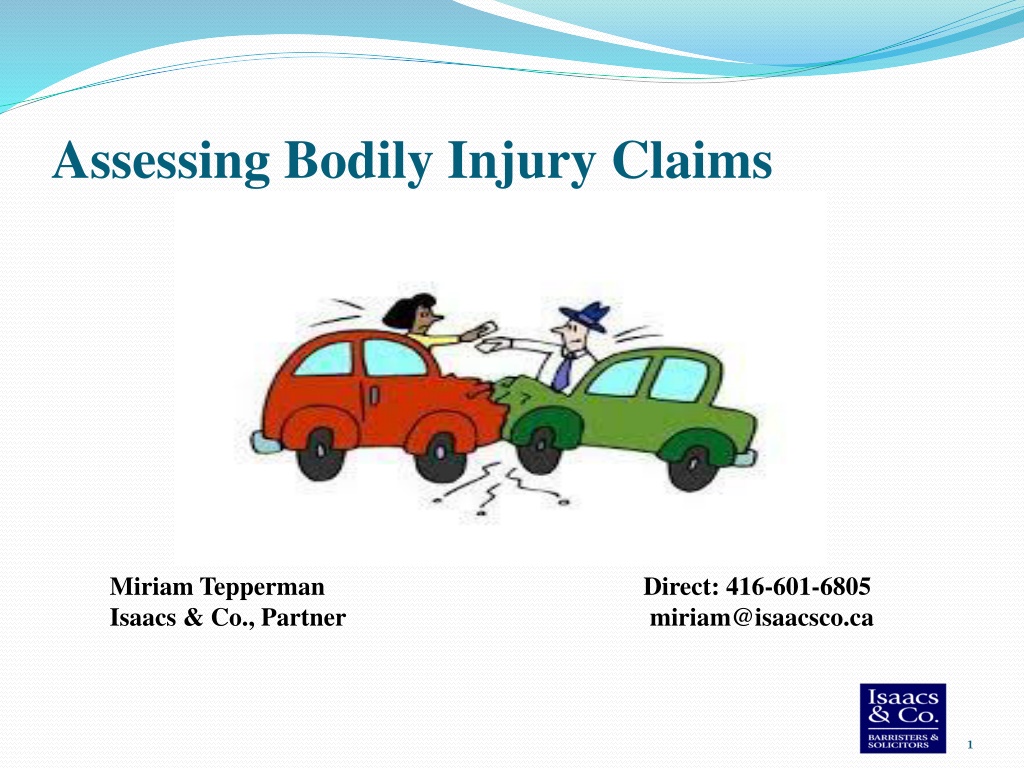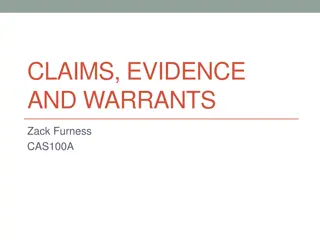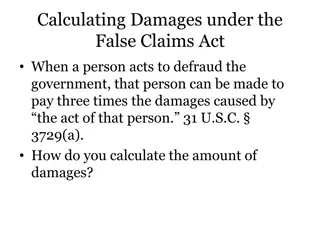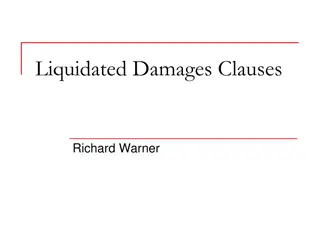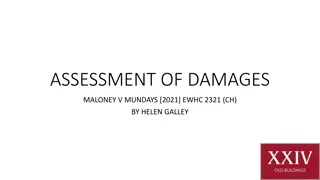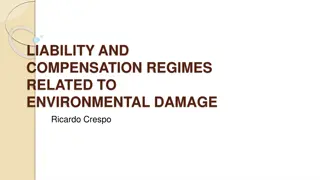Understanding Bodily Injury Claims: Types of Damages and Compensation
Explore the various types of damages in bodily injury claims, from general damages for pain and suffering to economic losses like past and future income. Learn about compensation for housekeeping, OHIP subrogated claims, medical care expenses, and out-of-pocket costs. Gain insights into assessing bodily injury claims effectively.
Uploaded on Sep 19, 2024 | 0 Views
Download Presentation

Please find below an Image/Link to download the presentation.
The content on the website is provided AS IS for your information and personal use only. It may not be sold, licensed, or shared on other websites without obtaining consent from the author. Download presentation by click this link. If you encounter any issues during the download, it is possible that the publisher has removed the file from their server.
E N D
Presentation Transcript
Assessing Bodily Injury Claims Miriam Tepperman Isaacs & Co., Partner Direct: 416-601-6805 miriam@isaacsco.ca 1
Table of Contents Types of bodily injury damages 1. The law behind general damages 2. Recent trends 3. Summary of recent case law 4. Conclusion 5. Q&A 6. 2
Part I Types of Damages in Bodily Injury Claims 3
Types of Damages in Bodily Injury Claims Examples of Major Heads of Damages 1. General Damages Otherwise known as damages for pain and suffering. Also known as non-pecuniary damages. Non-compensatory in nature as no money can provide true restitution. 4
Types of Damages in Bodily Injury Claims 2. Economic Loss a) Past loss of income claims for income lost as a result of the injury up to the date of trial. b) Future loss of income claims for future losses, which are proven on a balance of probabilities and are calculated in present day dollars. c) Loss of competitive advantage claims based on the theory that the injured plaintiff is limited in his or her ability to earn income, although not always in a mathematically calculable way. 5
Types of Damages in Bodily Injury Claims 3. Housekeeping and Home Maintenance Plaintiff may be entitled to compensation for housekeeping and home maintenance services that he or she is no longer able to perform. Past and future. 6
Types of Damages in Bodily Injury Claims 4. OHIP Subrogated Claims in Ontario The provincial health care provider may be entitled to claim for the reimbursement of the costs of health care expenses incurred by the plaintiff. Not applicable to MVA claims in Ontario. Similar legislation exists in Manitoba and British Columbia. 5. Past and future care Damages for medical care, either past or future, that the plaintiff will require as a result of the accident. 7
Types of Damages in Bodily Injury Claims 6. Out-of-pocket expenses Damages for any out-of-pocket expenses, such as clothing damaged in the accident, transportation costs to medical appointments, etc. 7. Prejudgment interest Provincial statutes governing court proceedings provide for prejudgment interest and usually set out a specified rate per quarter. Prejudgment interest typically runs from the date of loss. In Ontario MVA claims it runs from the date of the first notice. 8
Types of Damages in Bodily Injury Claims 8. Family Law Act damages Family members can claim for financial losses related to loss of care, guidance and companionship suffered as a result of the plaintiff s injuries. 9. Dependency claims Claims for compensation by dependents of the injured plaintiff. 10. Loss of interdependent relationships Damages that reflect the theory that a catastrophically injured person is less likely to have a life partner/spouse compared to a non-injured person. 9
This Presentations Focus Assessing general damages in bodily injury claims 10
Part II The Legal Principles behind General Damages 11
The Law of Damages Basic principle of Canadian law of damages is that the plaintiff should be put back into the position he or she would have been in had the accident not occurred. General damages, more correctly referred to as non-pecuniary general damages, are intended to compensate a plaintiff s pain, suffering and loss of enjoyment of life. Compensation for losses which do not have a financial calculation or source. While recognizing that the loss of good health cannot be valued in monetary terms, an award of general damages attempts to assess the compensation required to provide a plaintiff with reasonable solace for his or her injuries. So that an award of general damages is seen as fair, reference is made to awards made in comparable cases. However, each case requires an individualized assessment and is dealt with on its own facts because no two individual plaintiffs personal experiences are the same. 12
Factors to Consider Most important factors to consider when assessing general damages from the textbook, Personal Injury Damages, 2014 edition: The cap established by the Supreme Court of Canada; 1. The nature of the injuries; 2. The permanence of the injuries; 3. The degree of debilitation from normal day-to-day 4. activities; and The plaintiff s credibility. 5. 13
Thin Skull Principle A defendant must take the plaintiff as he/she is, even where because of a unique susceptibility or vulnerability, the injury was more dramatic or unexpectedly severe than one would expect an average person to sustain (Athey v. Leonati, [1996] 3 SCR 458). 14
Crumbling Skull Principle Athey v. Leonati (Supreme Court of Canada): The defendant need not put the plaintiff in a position better than his or her original position. The defendant is liable for the injuries caused, even if they are extreme, but need not compensate the plaintiff for any debilitating effects of the pre-existing condition which the plaintiff would have experienced anyway. The defendant is liable for the additional damage but not the pre-existing damage. 15
The Cap In 1978, the Supreme Court of Canada published a seminal trilogy of cases: Andrews v. Grand & Toy Alta. Ltd., [1978] 2 S.C.R. 229, Thornton v. Board of School Trustees of School District No. 57 (Prince George), [1978] 2 S.C.R. 267, Arnold v. Teno, [1978] 2 S.C.R. 287. The effect of these decisions was the creation of an upper limit or cap on the amount of general damages that could be awarded by a Canadian court. In 1978 the cap was set at $100,000. The cap does not apply to some cases, such as sexual assault and defamation claims. Since the cap was established, counsel and the courts have been using actuarial evidence to establish the present day value of the cap adjusted for inflation. The current amount of the cap is approximately $342,500 as was agreed by counsel and accepted by the court in the 2012 British Columbia case of Clost v. Relkie. 16
Vanishing Deductible Ontario has a system of vanishingdeductibles applicable to motor vehicle accident claims. In order to discourage litigation over minor claims, a deductible of $30,000 is applicable to awards of general damages and $15,000 is applicable to awards of damages for loss of care, guidance and companionship. However, no deductible is applied to awards of general damages in excess of $100,000 or awards in excess of $50,000 for loss of care, guidance and companionship. 17
Threshold in Ontario Only sufficiently serious motor vehicle accident claims can attract an award of general damages in Ontario. Section 267.5(5) of the Insurance Act states that no award of general damages will be made unless the injured person: Has died; or Has sustained serious disfigurement; or Has sustained a permanent serious impairment of an important physical, mental or psychological function. 18
Reference Materials The Compendium of Damages Awarded in Personal Injury Actions across Ontario Currently available version covers damage awards in Ontario up to October 1, 2012 Only deals with Ontario s case law http://c.ymcdn.com/sites/www.ccla-abcc.ca/resource/resmgr/pp- civlit/compendium_-_updated_up_to_o.pdf (or just Google the title) Goldsmith s Damages for Personal Injury and Death in Canada Loose-leaf digest service containing all recent bodily injury awards in Canada Can likely be found at any law library Personal Injury Damages, John R. Carlson & Karen D.P. Carlson Annual edition summarizing awards of damages across Canada Call Miriam For the most recent and custom estimate 19
Part III Recent Trends in Awards of General Damages 20
Recent Trends There has been an extremely broad range of awards of general damages in recent years: From $500 awarded to an Ontario plaintiff for minor injuries that were painless after 4 days and completely resolved after 14 days; To $326,000 awarded to a 71-year-old plaintiff who became a quadriplegic after she fell down a flight of stairs. Due to the large and constantly growing number of precedent decisions dealing with various types and combinations of injuries, there is generally some predictability in the assessment of general damages. The amounts of awards of general damages have generally been growing over the last decade. 21
Recent Trends Number of judicial assessments of damages and the average assessment amounts in British Columbia, Manitoba and Ontario in 2007-2013. Year British Columbia Manitoba Ontario Assessments Average $ Assessments Average $ Assessments Average $ 2013 157 65,200 0 n/a 18 72,000 2012 165 66,000 0 n/a 24 79,000 2011 89 76,000 3 35,000 18 66,000 2010 133 69,000 1 45,000 34 79,000 2009 184 60,000 15 15,000 22 70,000 2008 144 52,000 2 196,000 31 68,000 2007 102 54,742 0 n/a 28 73,040 *data obtained from John R. Carlson & Karen D.P. Carlson, Personal Injury Damages, 2014 Edition, (LexisNexis: Markham, 2014). 22
Recent Trends Judges generally focus more on the effect of an injury on a person s life than the label placed on the injury itself. Older plaintiffs tend to receive lower awards for the same injury than younger ones. Due to a more significant impact on self-esteem, girls get higher awards for scarring than boys, especially if the scarring is in an exposed area. Children generally get higher awards than adults for the same injury. 23
Soft Tissue Injury/Chronic Pain Cases 25
Soft Tissue Injury Soft tissue injury ( STI ) refers to damage to muscles, ligaments and tendons throughout the body. It can be a mild, moderate or severe injury. Common injuries are sprains, strains and whiplash. General range of STI awards: Mild/Minor injury: Moderate injury: Severe injury: $10,000 $40,000 $40,000 - $60,000 Generally $65,000 and up 26
Whiplash Whiplash is a very common soft tissue injury to the neck that usually occurs as a result of a motor vehicle accident. These injuries include whiplash and whiplash associated disorders (WAD), which range on a spectrum from Grade 0 to Grade 4: Grade 0 WAD: no complaints about the neck and no physical sign of injury Grade 1 WAD: neck complaint of pain, stiffness or tenderness only and no physical sign of injury Grade 2 WAD: neck complaint and muskuloskeletal signs of injury Grade 3 WAD: neck complaint and neurological signs of injury Grade 4 WAD: neck complaint and a fracture or dislocation 27
Whiplash Awards In both Ontario and British Columbia, recent awards have generally been between $30,000-80,000, however, general damages for whiplash could be: as little as $15,000 in Kapelus v. Hu, BCCA 2013; OR as high as $150,000 in Ward v. Klaus, 2010 BCSC Manitoba s awards in this area are dated but are within the same range. 28
Chronic Pain Chronic pain is often defined as any pain lasting longer than 12 weeks. Generally, it is the type of pain that persists over a long period of time. An initial injury, such as a sprain, can give rise to chronic pain over time. Because pain is a very personal and subjective experience, there is no test that can measure and locate pain with precision. Chronic pain is often accompanied by other problems such as fatigue, sleep disturbance, decreased appetite and mood changes. 29
Mild Soft Tissue Injury Djermanovic v. McKenzie, 2014 ONSC 1335 Plaintiff was a 42-year-old taxi driver involved in an MVA. Plaintiff complained of pain in his neck, back, shoulder area and headaches and was referred to physiotherapy and chiropractic treatment. There was conflicting medical evidence on the effect his injuries had on his life and his ability to return to work as a taxi driver. His credibility was a serious issue. Jury awarded general damages of $10,000, which would be reduced to $0 by the deductible, however, the action was dismissed on a threshold motion by the judge. 30
Mild Soft Tissue Injury Gulbrandsen v. Mohr, 2014 BCCA 359 Plaintiff was a passenger in a car involved in an MVA and complained of dizziness and pain in her upper back. The plaintiff missed 4 months of work and then returned on a graduated basis; was back to full-time hours within six months of the accident. In addition to ongoing dizziness, the plaintiff suffered mild to moderate soft tissue injuries to her upper back with few objective signs of injury. General damages of $25,000 gross. 31
Mild Soft Tissue Injury Rasmussen v. Blower, 2014 BCSC 1697 Plaintiff, aged 41, suffered whiplash-type soft injuries to his neck and back with related headaches in an MVA. His condition improved over time and would likely continue improving with a rehabilitation regimen, but it was possible that his symptoms might not resolve. Plaintiff s failure to persevere with the recommended physiotherapy and massage treatments amounted to a failure to mitigate his damage. General damages of $32,000, after a 20% reduction for failure to mitigate. 32
Moderate Soft Tissue Injury Kim v. Morier, 2013 BCSC 673 Plaintiff was a student who suffered injuries as a result of two MVAs. After the first accident, she was suffering from pain in her neck, lower back, hip and foot as well as headaches. Pain was severe but improved over time. She substantially recovered from her injuries when her vehicle was struck from behind again 14 months later. The second accident aggravated her injuries, re-injuring areas that had recovered. Her symptoms were not responding to treatment or medication and were responsible for the plaintiff s failing and having to repeat a year of her program of studies. The prognosis for resolution of the chronic pain was generally poor and her pain was not expected to fully resolve. General damages $55,000. 33
Moderate Soft Tissue Injury Ladret v. Stephens, 2013 BCSC 1999 Plaintiff, a 27-year-old, suffered from soft tissue pain in her heck, shoulder, mid-back, arm, both knees, hip and pelvis area after being involved in an MVA. She missed approximately a month of work after the accident. Her injuries resolved over time but she continued to complain of chronic pain in her mid-back. Since the accident, the plaintiff had gone though two pregnancies and maternity leave, had suffered a kidney infection, and had dealt with stress related to an abusive relationship. General damages $60,000. 34
Moderate Soft Tissue Injury Mezo v. Malcolm, 2013 BCSC 1793 Plaintiff was a pregnant 35-year-old executive assistant, who suffered injuries in an MVA. She complained of headaches, which at times were very severe, soft tissue pain in her neck and upper back and experienced nausea for several weeks. Plaintiff s symptoms caused discomfort while she was working and she could only maintain her workload by doing extra work on weekends. Plaintiff was fired from her job the day before trial. Her ability to do housework and care for the baby were affected and she required assistance with those tasks. Despite undergoing massage therapy, acupuncture, yoga and exercises, she was unable to return to her pre-accident level of physical activity and it was likely that her symptoms would continue. General damages $60,000 gross. 35
TMJ Daitol v. Chan, 2012 BCSC 209 Plaintiff, aged 31, suffered injuries in an MVA and complained of pain in her knee, jaw, neck and lower back. She did not work for 3 weeks after the accident. Most of her injuries resolved over time, but she continued to complain of TMJ pain and pain in her left knee. It was very significant that the one physical activity that the plaintiff used to enjoy, walking, had been lost to her. General damages $60,000. 36
Severe Soft Tissue/ Chronic Pain Tennant v. Fariba, 2013 ONSC 1676 Tennant was a 40-year-old self-employed flooring installer who suffered damages when his vehicle was sideswiped. He underwent physiotherapy and took pain medication but continued to experience shooting pain in his left knee and ongoing pain in his right arm and hand. He was able to return to work but his injuries impacted the efficiency of his work. Plaintiff s symptoms improved with use of medication but he continued to experience ongoing depression, lack of energy and suffered from chronic pain disorder. General damages $65,000. 37
Severe Chronic Pain Smith v. Fremlin, 2014 BCCA 253 Plaintiff was a 31-year-old articling student who suffered soft tissue injuries when her vehicle was struck from behind. She complained of significant soft tissue pain in her neck, back and left shoulder. Her injuries improved over time but her shoulder pain did not resolve and continued to impact her daily activities and housekeeping tasks, recreational activities and her ability to use a mouse while working at a computer. She was no longer able to pursue her chosen career path to be a lawyer and instead chose to pursue becoming a professor at a law school. General damages $90,000. 38
Fractures & Tears There is a very broad range of awards for fractures and tears. It is very important to look at how each individual plaintiff s life is affected by the injury. A simple broken bone that heals quickly may attract an award of under $20,000. An injury requiring surgery and bone fixation with a significant impairment of the plaintiff may attract an award of $50,000 or more. Multiple fractures with extensive disability could lead to awards of over $100,000. 40
Fracture - Clavicle Mikolic v. Tanguay, 2013 ONSC 7177 A 34-year-old drywall installer suffered a fracture to his clavicle in an MVA. The fracture required internal fixation, surgery & the hardware was removed 4 years after the accident. The medical evidence established that the fracture healed well. He developed chronic pain, depression, and mild cognitive deficits which would likely continue on a permanent basis. Jury awarded general damages of $35,000, which was reduced to $4,000 by the operation of the deductible of $30,000 and a reduction of 20% for contributory negligence. 41
Tear - Shoulder Bideci v. Neuhold, 2014 BCSC 542 Plaintiff, aged 93, suffered a full thickness tear in his right shoulder rotator cuff when he fell in the process of standing up from his seat on a bus. Prior to the accident, plaintiff s medical conditions included severe osteoporosis and osteoarthritis, neck and back pain, shoulder pain and general frailty. Plaintiff was referred to physiotherapy for the tear. Plaintiff had been advised not to use the conventional transit system unassisted due to his medical state. Plaintiff s failure to follow most medical recommendations regarding physiotherapy treatments was ruled to amount to failure to mitigate damages. General Damages $35,000 before a reduction of 1/3 for contributory negligence. 42
Fracture & Tear - Shoulder Grayling v. Haldimand (County), 2014 ONSC 198 A 49-year-old hairdresser tripped and fell on her right arm, suffering a fracture of her shoulder joint and a tear of her rotator cuff. Plaintiff was able to return to work in a few months but continued to suffer pain which led to her only being able to work reduced hours. She would likely suffer permanent difficulty with social activities, domestic chores and performing tasks of her job as a hairdresser. General damages $50,000 before a 50% reduction for contributory negligence. 43
Fracture/Tear - Shoulder Chabot v. Chaube, 2014 BCSC 300 Plaintiff was a 25-year-old university student who was struck by a vehicle while rollerblading across a crosswalk. She suffered a high- grade partial thickness soft tissue tear and a small rotator cuff tear. Her ability to work in her chosen field and to engage in the active lifestyle she had prior to the accident was impacted by her ongoing chronic and permanent condition. Plaintiff could require further arthroscopic surgery on her shoulder. General Damages $80,000 minus a 10% reduction for contributory negligence. 44
Tear - Shoulder Donovan v. Parker, 2014 BCSC 668 Plaintiff was a 34-year-old logging truck driver who suffered injuries when his vehicle was sideswiped. He was diagnosed with a rotator cuff tear which over time led to atrophying of a part of the muscle in his rotator cuff. Pain from the injury caused the plaintiff difficulty sleeping. He was able to return to work but the injury impacted his ability to perform the tasks required in his physically demanding job. Plaintiff s limitations were found to be permanent and could worsen over time. General damages $90,000. 45
Fracture - Hand Albert v. Politano, 2013 BCCA 194 Plaintiff, a professional boxer, was travelling in a vehicle which was sideswiped and then struck a utility pole. While initially the plaintiff suffered soft tissue injuries to his neck and back, impact injury to his head, headaches and an injury to his right hand, all his symptoms, except for the hand injury, resolved over time. Plaintiff s hand injury permanently impacted his career as a professional boxer. General damages $125,000. 46
Tear - Knee Walker v. Stratford (City), 2013 ONSC 7618 Plaintiff suffered injuries when he stepped off the curb to get to his parked car and his foot went into a pothole. He fell and twisted his right knee during the fall. Plaintiff was diagnosed with a torn meniscus in his right knee. Surgery was performed to repair the injury. General damages $25,000. 47
Tear - Knee Hillman v. Esaryk, 2014 BCSC 170 Plaintiff, aged 19, worked as an airline porter when he injured his left knee in an MVA. The injury impacted his ability to exercise, get in and out of planes, squat, or generally put any stress on his knee. Plaintiff underwent arthroscopic knee surgery. He took a month off work but had significant improvements with physiotherapy. After a month, his symptoms were essentially recovered with only occasional nagging symptoms that were not in any way disabling. General damages $40,000. 48
Fracture - Knee Tenhunen v. Tenhunen, 2015 BCSC 26 61-year-old plaintiff nurse was injured in a slip and fall on a wheelchair ramp. She suffered a fracture to her left tibial plateau and was put in a full length knee immobilizer. Rested at home for 5 days. Was unable to bear weight on her left leg for upwards of four months and missed three months of work. She was found to be a lot less active and energetic in life after the injury. Returned to work but continued to suffer pain and it was expected that her symptoms would impact her future earning capacity. General damages of $80,000 before a reduction of 50% for contributory negligence. 49
Fracture - Jaw Dickie v. Minett, 2014 ONCA 265 (Ont. C.A.) Plaintiff was a labourer in the construction industry who suffered a fractured jaw during removal of his wisdom teeth as a result of medical negligence. His jaw had to be wired shut for approximately 8 weeks, during which time, he could not work and ended up losing his job. His pain gradually dissipated, but he was left with permanent numbness and tingling in the right side of his lip and chin. Plaintiff was an accomplished bagpipes player prior to the injury and was no longer able to play the instrument. The plaintiff s claim was dismissed, but general damages were provisionally assessed in the amount of $35,000. 50
